There is no magic in a spotting scope; it just looks that way.
Photo: Spotting scopes are ideal for open-country hunting, but they also can be used to spy on isolated fields in the east and Midwest, often from miles away.
There were nine of us sharing the alpine tundra just below the snow line in Alaska’s gorgeous Chugach Range. It was early September, the fall colors were blazing, and it had quit snowing. There was just one problem: the five horned members of our group were napping about five miles from the four non-horned members.
According to Alaska Fish & Game regulations, the two licensed hunters in our gang of four could not legally shoot any Dall’s sheep unless its horns came full circle or showed at least eight years of growth rings. And we were supposed to determine this from five miles away?
Sure. Piece of cake. We had a spotting scope.
“I’m saying the one of the left is legal,” outfitter Lance Kronberger declared. “What do you guys think?” He loosened the locking screw on his Swarovski 65mm scope and twisted its 20-60x eyepiece toward Scott Grange and me.
“After you, Alphonse,” I demurred. Scott stuck his right eye to the glass and studied. And studied. A long time he studied. Then he backed away, and I took my turn.
“Holy ----! Are you kidding? I’m not calling this.” Despite the power of that optical instrument, despite cold, pristine mountain air freshly washed of any remnant pollution particles, the sheep in that eyepiece were specks. And their horns were speckier.
“Keep watching,” Lance suggested. “Wait until he turns just so. See if his tips curl all the way up.” I did, the ram did and, by golly, they did. Let’s play ball!
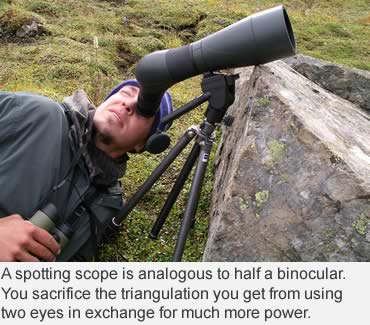 The result of our highly magnified spying on that hunt were a pair of 38-inch rams.
The result of our highly magnified spying on that hunt were a pair of 38-inch rams.
There is no magic in a spotting scope. It just looks that way. And smart guides like Lance Kronberger take full advantage of this highly magnified look because it not only saves them miles and hours, but also helps them find the critters they’re paid to find.
But what about the rest of us common everyday hunters no one is paying to find game? Do we need spotting scopes? Even if we’re only hunting whitetails? And if so, how much do we need to spend to get a useful model?
Honest answer: no one needs a spotting scope. But then, no one needs a rifle, either. Humans were bagging mastodons with spears thousands of years ago. But if you prefer using a rifle, you might like working with a spotting scope, too. Used properly, it can help you find more game and save you hours of wasted time and steps. Think of it as your ultimate, portable scouting aid.
But not just any spotting scope will work. As with any other optic, some are better than others. It helps to know what makes them work and work well.
A spotting scope is, of course, a telescope. The main tube is fairly long because distance from the curved objective lens to its focusing point increases magnification. Fortunately, that length is augmented by a prism. Like the prisms within a binocular, a spotting scope’s prism is designed to bend the light path to maintain a long distance of travel for high magnification without having to stretch the main tube longer than your leg. By bouncing the light from one surface of the prism to another and another and another — up to five times — adds a lot of distance in a short, squat shape. This makes spotting scopes much more compact.
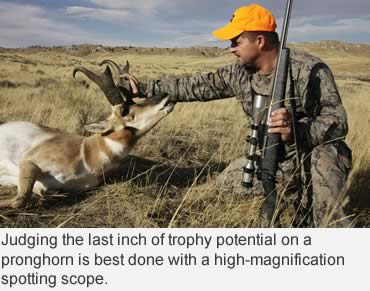 But even a prism isn’t enough to raise magnification as high as 45x or 60x, common top-end power in most spotters. That is done with magnifying eyepieces. The lenses within the eyepiece act like a magnifying glass to further enlarge the already magnified imaged passed through the objective lens and prisms.
But even a prism isn’t enough to raise magnification as high as 45x or 60x, common top-end power in most spotters. That is done with magnifying eyepieces. The lenses within the eyepiece act like a magnifying glass to further enlarge the already magnified imaged passed through the objective lens and prisms.
A spotting scope, then, is analogous to half a binocular. Yes, it’s a compromise. You sacrifice the triangulation you get from using two eyes in exchange for much more power. Most high quality spotting scopes weigh 3 to 4.3 pounds. Connecting two with a bridge would result in a 7- to 10-pound binocular — not something most hunters would be eager to carry.
All the optical laws and limitations inherent in a binocular apply to a spotting scope. Thus, the diameter of the objective divided by the magnification determine the exit pupil, the little circle of light that passes from the eyepiece to enter your own pupil. If this is smaller than your pupil, you lose brightness. A 65mm objective at 20x yields a 3.25mm exit pupil. Crank that 20x to 40x and the EP shrinks to 1.625mm. In bright daylight, the human pupil shrinks no more than 2mm, so this 40x spotter is making things look dim under the best of conditions. Twist it up to 60x, and hoo-boy. A 1.08mm EP!
The solution is to, duh, increase objective lens diameter. So let’s jump up to a big 80mm. This’ll raise the weight from 3 pounds to 4 and the price – well, that’ll jump $100 to $500, too, depending on the brand and model. And our EP? At 40x, it will enlarge to 2mm. At 60x, it’s 1.33mm. Not exactly migraine inducing brightness, is it?
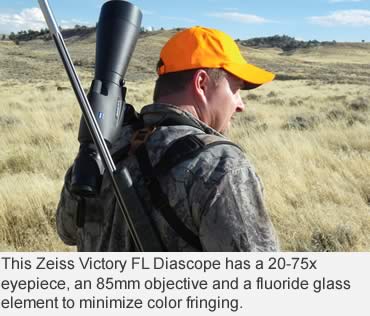 The fortunate thing is that the phenomenon called “twilight factor” ameliorates the diminutive EP. TF refers to the very real benefit of seeing a greatly enlarged image.
The fortunate thing is that the phenomenon called “twilight factor” ameliorates the diminutive EP. TF refers to the very real benefit of seeing a greatly enlarged image.
Even though the light is extremely low, the sheer size of the image helps you figure things out. Compare this to observing a dark object beside the trail at twilight. At 100 yards, it looks to be a black bear or maybe a stump. Walk to 10 yards and, even though it hasn’t gotten any lighter out, you’ll be able to see it’s just a stump because it’s larger. So it goes with a spotting scope. As you crank up the power, the image dims, but because it’s so much larger, you can generally determine more detail. All of this depends on ambient light, of course. At some point the light level is so low that not even a great TF helps.
Fortunately, there’s other ways to brighten the image: anti-reflection coatings. We optics writers harp about these coatings ad nauseum for good reason. They are the real cause of useable brightness in optics. Anti-reflection coatings weigh nothing, don’t increase physical size of anything and can increase brightness as much as 65 percent. Here’s how: raw glass reflects about 4 percent of light that strikes it and another 4 percent that leaves it. Multiply this times the 10 to 16 lens/prism surfaces in a spotting scope and you’re losing more light than you’re transmitting. But apply a single, molecularly thin layer of anti-reflection coating and you cut this loss in half. Apply more and more layers and you can reduce it to a reflection loss at each air-to-glass surface as low as 0.2 percent.
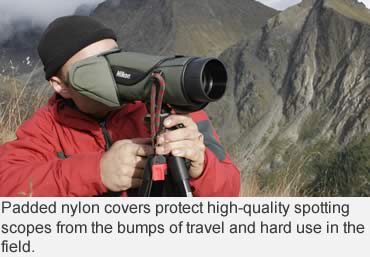 Now for the bonus. When anti-reflection coatings minimize reflection, they increase contrast by preventing reflected light from bouncing internally, lens to lens to lens, creating a veiling haze typically seen as a “fog” over the view. You’ve probably seen this as an orange haze when looking toward the sunset with a cheap binocular.
Now for the bonus. When anti-reflection coatings minimize reflection, they increase contrast by preventing reflected light from bouncing internally, lens to lens to lens, creating a veiling haze typically seen as a “fog” over the view. You’ve probably seen this as an orange haze when looking toward the sunset with a cheap binocular.
When this uncontrolled light is eliminated, the view is saturated with deep color, raising the contrast so you detect subtle differences in colors like bark brown and antler brown. Insist on multiple layers of the best anti-reflection coatings if you want the highest light transmission and minimum flare through your spotting scope.
Unfortunately, there is no way to determine the quality or layers of these coatings in any particular scope. Each maker guards its “secret, proprietary” anti-reflection coating recipe. I suspect they aren’t all that different, but as consumers, we’re relegated to a “what you see is what you get” method of comparing. If you manage to gather two or more spotters for side-by-side testing in low light, you’ll quickly separate the wheat from the chaff. But among the top line competitors, you’ll be hard pressed to notice subtle differences in total brightness.
The prism contributes to brightness, too, based on how efficiently it reflects light. An Abbe-Koenig prism and Porro prism are both shaped to provide total internal reflection without aid of a mirror, but the Schmidt-Pechan prism needs at least one mirrored surface. The cheap ones use an aluminum backing (87 to 93 percent reflectance) the better ones a silver backing (95 to 98 percent,) and the best use something called a non-metallic dielectric mirror (99 percent) applied via vapor deposition much like anti-reflection coatings.
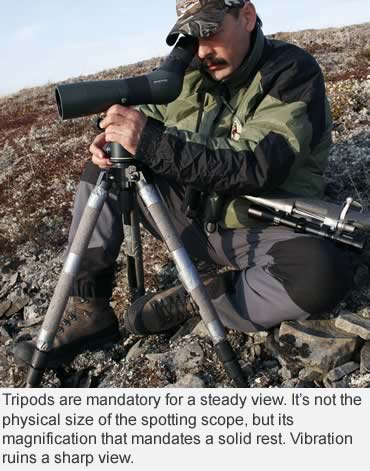 HD glass, also called APO, FL and ED glass, is being hyped as the latest and greatest for optical quality, but has nothing to do with enhanced brightness. The HD part of a scope is usually the objective lens. It will include fluoride crystals in its composition. This makes it more easily scratched than regular glass, so it’s usually protected by a hard glass cover. High Definition glass minimizes refraction (bending) of white light into the many colors of the rainbow. This in turn makes it easier to bring all those color bands back to the same focus point to recreate a normal “white light” image without color fringing softening the edges. This fringing, essentially different colors of the image slightly overlapping one another, becomes increasingly apparent and objectionable above 20x, so minimizing it with ED glass is quite valuable in a high-power spotting scope. It can be corrected with additional lenses instead of fluoride HD lenses, but these add weight and increase light loss. Are HD lenses worth it? Sometimes.
HD glass, also called APO, FL and ED glass, is being hyped as the latest and greatest for optical quality, but has nothing to do with enhanced brightness. The HD part of a scope is usually the objective lens. It will include fluoride crystals in its composition. This makes it more easily scratched than regular glass, so it’s usually protected by a hard glass cover. High Definition glass minimizes refraction (bending) of white light into the many colors of the rainbow. This in turn makes it easier to bring all those color bands back to the same focus point to recreate a normal “white light” image without color fringing softening the edges. This fringing, essentially different colors of the image slightly overlapping one another, becomes increasingly apparent and objectionable above 20x, so minimizing it with ED glass is quite valuable in a high-power spotting scope. It can be corrected with additional lenses instead of fluoride HD lenses, but these add weight and increase light loss. Are HD lenses worth it? Sometimes.
The zoom feature in spotting scopes is done with the magnifying eyepieces, so you can switch from a fixed 20x, 30x, 45x to a zoom 15-45x or 20-50x or 20-60x, etc. merely by screwing on the new eyepiece. The lower powers are ideal for scanning or finding your target before zooming tighter. Variable powers are also ideal for finding the optimum magnification for atmospheric conditions. High magnifications become unusable in dirty, hazy or hot air. Low light levels make any power above 40x difficult to use, too. Wind creates vibrations that are magnified at higher powers. Because shaking messes up a high power view, spotters must be used on sandbags or tripods to be fully effective.
Eyepiece shape, straight or angled, is a personal choice. Straight units make it easier to find targets with a natural aim. Angled units take a bit of getting used to, but once mastered are more comfortable to use. You can arrange them to look down into from a natural sitting position. No bending and craning of the neck required. By twisting the body in its collar, you can angle the eyepiece down and watch from a supine position or swing the unit to the side for someone else to use without moving it off target. Most serious hunters/glassers eventually convert to angled eyepieces.
Focus knobs can become critical at high magnifications. Those with low gear ratios can be fine-tuned without running past the focus point. Some of the best units include two focusing knobs, one for gross, fast focus, another for slower fine-tuning. Zeiss includes a dual-speed in one focus wheel on its Victory diascopes.
The best scopes retail for $2,000 to over $3,000. Must we spend this much? No. You can get good to remarkable optical quality for less. Watch sales and you can pick up Nikon’s excellent ED Fieldscope 25-75x82mm for under $2,000, its non-ED Fieldscope II in 20-60x60mm for under $1,000.
Alpen’s award-winning spotters sell for as little as $400 in 20-60x80mm.
For years, I hunted successfully with a Bushnell Trophy 20-60x65mm that can be found on sale these days for under $200. The least expensive units are not perfect, but they’re a good start.
Yes, it’s smart to get the best spotter you can afford. But it’s foolish to not get one when a magnified view helps you locate game you’d otherwise miss.
Read Recent GunHunter Articles:
• Chronograph Reliability: Many variables can affect velocity readings. Here’s how to set up for best results.
• Legacy of the ’98 Mauser: Can you think of any 19th century product still being made and used today? Such is the genius of Peter Paul Mauser’s M98.
This article was first printed in the September 2011 edition of Buckmasters GunHunter Magazine. Subscribe today to have GunHunter delivered to your home.